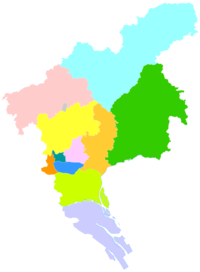Nansha District
Nansha
南沙区 / 南沙新区 | |
|---|---|
District & State-level new area | |
 Nansha Temple of Tianhou (Mazu) | |
 | |
 Nansha in Guangzhou | |
| Coordinates: 22°50′18″N 113°36′30″E / 22.83833°N 113.60833°ECoordinates: 22°50′18″N 113°36′30″E / 22.83833°N 113.60833°E | |
| Country | People's Republic of China |
| Province | Guangdong |
| Sub-provincial city | Guangzhou |
| Area | |
| • Total | 544.12 km2 (210.09 sq mi) |
| Population (2012) | |
| • Total | 260,000 |
| • Density | 480/km2 (1,200/sq mi) |
| Time zone | UTC+8 (China Standard) |
| Postal code | 440115 |
| Area code(s) | 020 |
| Website | http://www.gzns.gov.cn/ |
| Nansha District | |||
|---|---|---|---|
| Simplified Chinese | 南沙区 | ||
| Traditional Chinese | 南沙區 | ||
| Guangdong Romanization | nam4 sa1 kêu1 | ||
| Hanyu Pinyin | Nánshā Qū | ||
| |||
| Alternative Chinese name | |||
| Simplified Chinese | 南沙新区 | ||
| Traditional Chinese | 南沙新區 | ||
| Guangdong Romanization | nam4 sa1 sen1 kêu1 | ||
| Hanyu Pinyin | Nánshā Xīnqū | ||
| |||
| Second alternative Chinese name | |||
| Chinese | 南沙 | ||
| Guangdong Romanization | nam4 sa1 | ||
| Hanyu Pinyin | Nánshā | ||
| Literal meaning | south sands | ||
| |||

Nansha District and Nansha New Area is one of 11 urban districts and a state-level new area of the prefecture-level city of Guangzhou, the capital of Guangdong Province, China. It is the home of the present-day port of Guangzhou, as well as the Nansha Wetland Park.
The Nansha Technology Development Zone was carved out of Panyu District in 1993. In 2005, it was named Nansha District. In September 2012, Nansha was designated a State-level New Area as Nansha New Area, the sixth such area.[1]
New area[]
Nansha is the newly established state-level new area (special economic and political administration zone) under the direct control of Guangzhou Municipal Government on September 2012.[2]
On September 2012 Nansha New Area was approved by the State Council of China's Central Government as the sixth state-level new area (followed by Pudong of Shanghai, Binhai of Tianjin, Liangjiang of Chongqing, Zhoushan of Zhejiang, and Lanzhou New Area, Gansu), which is also the first state-level new development area in South Central China.
Administrative divisions[]
| Name | Chinese (S) | Hanyu Pinyin | Canton Romanization | Population (2010)[3] | Area (km2) |
|---|---|---|---|---|---|
| Nansha Subdistrict | 南沙街道 | Nánshā Jiēdào | nam4 sa1 gai1 dou6 | 112,151 | 57.80 |
| 珠江街道 | Zhūjiāng Jiēdào | ju1 gong1 gai1 dou6 | 28,575 | 41.50 | |
| 龙穴街道 | Lóngxué Jiēdào | lung4 yud6 gai1 dou6 | 44,891 | 128.90 | |
| Town | 万顷沙镇 | Wànqǐngshā Zhèn | man6 king2 sa1 zen3 | 319.20 | |
| Huangge Town | 黄阁镇 | Huánggé Zhèn | wong4 gog3 zen3 | 43,791 | 76.50 |
| Town | 横沥镇 | Hénglì Zhèn | wang4 lig6 zen3 | 30,492 | 54.00 |
| Dongchong Town | 东涌镇 | Dōngchōng Zhèn | dung1 chung1 zen3 | 147,228 | 92.00 |
| Town | 大岗镇 | Dàgǎng Zhèn | dai6 gong1 zen3 | 125,011 | 90.07 |
| Lanhe Town | 榄核镇 | Lǎnhé Zhèn | lam5 hed6 zen3 | 73,078 | 74.48 |
Transportation[]
Metro[]
Nansha is currently served by one metro line operated by Guangzhou Metro:
- Line 4 - Dongchong, Qingsheng, Huangge Auto Town, Huangge, Jiaomen, Jinzhou, Feishajiao, Guanglong, Dachong, Tangkeng, Nanheng, Nansha Passenger Port
References[]
- ^ China Daily Nansha New Area launched Updated: 2012-09-13 14:56 "China has mapped out a new State-level development zone in South China's Guangdong province, the Shanghai Securities News reported on Wednesday. As the country's sixth State-level New Area, the Nansha New Area is expected to get national support from a series of preferential policies and innovation reforms on tax policy, land management, financial innovation and industrial development. The other zones are in Shanghai, Tianjin and Chongqing, as well as Zhejiang and Gansu provinces."
- ^ China Daily Nansha New Area launched Updated: 2012-09-13 14:56 "China has mapped out a new State-level development zone in South China's Guangdong province, the Shanghai Securities News reported on Wednesday. As the country's sixth State-level New Area, the Nansha New Area is expected to get national support from a series of preferential policies and innovation reforms on tax policy, land management, financial innovation and industrial development. The other zones are in Shanghai, Tianjin and Chongqing, as well as Zhejiang and Gansu provinces."
- ^ shi, Guo wu yuan ren kou pu cha ban gong; council, Guo jia tong ji ju ren kou he jiu ye tong ji si bian = Tabulation on the 2010 population census of the people's republic of China by township / compiled by Population census office under the state; population, Department of; statistics, employment statistics national bureau of (2012). Zhongguo 2010 nian ren kou pu cha fen xiang, zhen, jie dao zi liao (Di 1 ban. ed.). Beijing Shi: Zhongguo tong ji chu ban she. ISBN 978-7-5037-6660-2.
External links[]
| Wikimedia Commons has media related to Nansha District. |
- Nansha District




